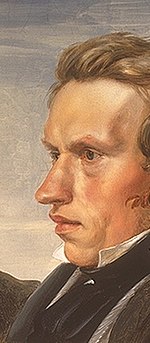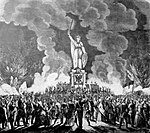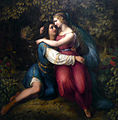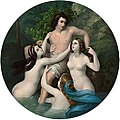Karl Ferdinand son


Karl (Carl) Ferdinand Sohn (born December 10, 1805 in Berlin , † November 25, 1867 in Cologne ; also C. Sohn the Elder ) was a German painter .
Life
His parents were Johann Samuel Sohn and Louise, née Gendrich, both from Prenzlau in the Uckermark . At the age of 18, his son became a student at the art academy in Berlin. After he had completed all classes, his son moved to Wilhelm von Schadow's private studio . Together with Eduard Bendemann , Christian Köhler , Heinrich Mücke , son Schadow followed in 1827 to Düsseldorf at the art academy there .
His first painting Rinaldo und Armida (1828), which was completed in Düsseldorf and shown in the first exhibition of the Kunstverein für die Rheinlande und Westfalen in 1829, earned him admiration. At the art exhibition in Berlin in 1830, the painting The Rape of Hylas was positively highlighted by the critics.
He made study trips to Holland and Belgium ; Together with the Eduard Bendemann family , Theodor Hildebrandt and the Julius Hübner family , he accompanied Schadow to Rome in 1830 . Karl Ferdinand Sohn stayed in Italy until 1831. The works of art viewed there, the study of the Venetian masters, the magic of the south were powerful and steered his own works in a romantic direction.
For his first paintings, Sohn found the subjects of antiquity , but he also thematized works of literature, including The Bath of Diana (1833) for Friedrich Wilhelm III. von Prussia , The Two Leonors (1834) first version based on Johann Wolfgang von Goethe's Torquato Tasso , The Judgment of Paris (1836) and Romeo and Juliet (1836) based on William Shakespeare . He also created figure pictures that were not based on literary models, such as The Lute Player (1832) and The Two Sisters . However, the number of his history pictures was not large and only lasted until 1853, as he was heavily used by portrait painting and his teaching activities.
“His special technical talent outweighed that of his classmates as well as that of the teacher himself, and in his first pictures he shows himself to be a virtuoso in the treatment of his comrades. [...] Beautiful girls and young men, charming women in all the splendor of a lush existence, in quiet situations, are the objects of his paintings, [...] Even in his first pictures S. overcame the greatest difficulties of painting, he proved himself as a master in the representation of the naked, as a flesh painter of the first order. S. was above all a colorist, a colorist in the sense of Tizian's, but not an imitator of this master, his manner of representation is quite peculiar to him. "
In 1832 Schadow made him deputy for Heinrich Christoph Kolbe at the Düsseldorf Art Academy ; Carl Friedrich Lessing had refused to represent him in the Antikensaal . In 1833 Rudolf Jordan , who came from Berlin, became his pupil. In the same year, Sohn became a member of the Prussian Academy of the Arts in Berlin. When he was appointed professor in 1838, he took over the antiquities hall as well as a painting class and the preparatory class until 1855 .
After that he left his official business at the academy on hold for four years, but stepped in for the sick Schadow in 1859 and headed a painting class until his death.
The Düsseldorf School of Painting , initially shaped by Peter von Cornelius and Wilhelm von Schadow , gave priority to historical and monumental painting. Sohn's influence on the Düsseldorf painting school is not to be underestimated. He was extremely effective as a teacher: almost all of the artists at the Düsseldorf School were his students for a shorter or longer period, and the technology at the Düsseldorf School is largely due to his teaching. He was in the highest esteem among his students, and his corrections were valued more than those of any other teacher, for they were always short and to the point and pointed to what was characteristically important. One of his most important students was Anselm Feuerbach .
None of his students imitated him, because they had trained very differently under his direction. In addition to the academic classes with students, Sohn had a studio in which he taught numerous private students over the years, including Amalie Bensinger , Julie von Egloffstein , Sara Hendriks , Jenny Eckhardt , Herminia Borchard , Christine Hoeffler (1827–1878), Minna Japha (1828–1882), Elisabeth Jerichau-Baumann , Wilhelmina Lagerholm , Luise von Martens , Amalie Murtfeldt , Sofie Ribbing , Auguste Schepp , Antoinette “Tony” Schnitzler , the daughter of Anton Schnitzler , Johanna Unger (1836–1871), Marie Wiegmann , Clara von Wille , Louise Desert , Minna Ziel as well as the women from Alvensleben, Neussel and von Schulte, who cannot be identified more precisely by means of artist encyclopedias. His nephew and son-in-law Wilhelm Sohn and Ludwig des Coudres had distinguished themselves among his private students . The Anglo-Irish MP, John Leslie, was one of his students.
As a person, Son enjoyed the highest general respect and ran his household on a grand scale. He had a calm, solid nature with simplicity and amiability. In addition to his high level of painterly skill, his ability to balance ensured son had a lasting, educational effect. His highest art unfolded in the female portraits. The ability for a sensitive and sensual naturalism brought son numerous portrait commissions with clients from the aristocracy and the rising upper class as far as Russia and the USA . This required all his strength in his last years. Among the numerous portraits, there are only a few to name: Stephanie von Hohenzollern-Sigmaringen , Sophie Eugenie Freifrau von Mumm, Adelheid Marie von Anhalt-Dessau , Princess von Croy , Charlotte von Reutern , Mrs. Marie Antoinette Stein (née Jung), his wife Friend and composer Hiller in Cologne, the wife of Paul von Joukowsky , the wife of Wilhelm Joest in Cologne, the wife of Theodor von Bunsen , Mathilde Wesendonck , her mother Johanna Luckemeyer, his student Marie Wiegmann and his wife Emilie, whom he himself greatly admired Auguste.
“They are of extraordinary beauty and grace, he knew how to give them a true nobility of appearance, he saw nature from its most beautiful side. For S. can by no means be called an idealist according to a preconceived scheme, his ideal figures never lack individual characteristics, but the appearance in his representation is to a certain extent raised above itself and everything unpleasant, accidental, petty is stripped from it. He had less success with male portraits, in which his style of representation always seems a bit soft. "
In 1840 Karl Ferdinand Sohn had the architect Rudolf Wiegmann , the husband of his pupil Marie Wiegmann, build a detached semi-detached house at Klosterstrasse 23-25 (before 1870: Pfannenschoppenstrasse 33) in Düsseldorf . The second half was inhabited by Johann Wilhelm Schirmer and, from 1846, the Wiegmann family. At the inauguration of Karl Ferdinand Sohn's house on December 31, 1844, Rudolf Wiegmann read a poem. This house had a facade painted using a fresco technique. The duplex no longer exists. Her immediate neighbors at Pfannenschoppenstrasse 35 were Alwine and Adolph Schroedter during her time in Düsseldorf .

Karl Ferdinand Sohn was closely intertwined with the cultural and political life of Düsseldorf. During the unrest in 1848, known as the March Revolution , which led to the German National Assembly and thus to the adoption of the constitution , Karl Ferdinand Sohn also took part in the political discussions. On August 6, 1848, the Düsseldorf “ Association for Democratic Monarchy ” proclaimed the “ Festival of German Unity ”, to which painters and sculptors contributed with their artistic design. Sohn designed the Germania figure (then created by Dietrich Meinardus ) out of wood, cardboard and canvas, with a raised sword in her right hand, fifteen feet high. In the enthusiasm for the national ideals, the artists' association Malkasten was founded that same evening as part of the celebrations . Son was one of the founding members along with other academy professors and painters.
At Christmas 1853, Clara Schumann gave her husband a portrait painted by Karl Ferdinand Sohn. In September 1850, Sohn was part of the reception committee that welcomed the Schumanns when they arrived in Düsseldorf.
On November 25, 1867, at the age of almost 62, Karl Ferdinand Sohn died of a stroke while visiting his friend Ferdinand von Hiller in Cologne.
Honor
The Sohnstraße in the Düsseldorf district of Düsseltal was named after Karl Ferdinand Sohn.
family
Karl Ferdinand Sohn married Emilie Auguste (1805-1884), a daughter of Friedrich Carl Ludwig von Mülmann (1775-1857), chief forest master of Düsseldorf, and Johanne Sophie Luise (1779-1815), born on January 18, 1834 in Düsseldorf . Hartig, a sister of the forest scientist Georg Ludwig Hartig . Her youngest sister Sophie Pauline (1811–1863) was married to the painter Rudolf Jordan . His wife's brother was the Düsseldorf government councilor Otto von Mülmann .
They had five children. His sons were the portrait and genre painters Paul Eduard Richard Sohn (1834–1912) and Carl Friedrich Rudolph Sohn . The latter married Else Sohn-Rethel (1853–1933), the daughter of the painter Alfred Rethel . Clara, the eldest daughter, was married to the music director and composer Albert Dietrich . The painter Wilhelm Sohn was his nephew and student and married his youngest daughter Emilie; so the nephew also became a son-in-law. The daughter Marie married the painter Karl Hoff .
Master student
- Anselm Feuerbach
- Marie Wiegmann
- Amalie Bensinger
- Elisabeth Jerichau-Baumann
- Heinrich Ludwig Philippi
- Clemens Bewer
Works
Marie Wiegmann , 1845
Maria Mikhailovna Romanova , 1847
Mathilde Wesendonck , 1850
- Rinaldo and Armida, after 1828 ( Museum Kunstpalast , Düsseldorf)
- The robbery of Hylas 1830 (transferred from imperial property in 1876, re-inventoryed in 1934. 1945 lost in the flak tower zoo)
- Collective portrait: The Schadow Circle (the Bendemann family and their friends) by Eduard Bendemann, Theodor Hildebrandt, Julius Hübner, Wilhelm von Schadow, and Karl Ferdinand Sohn (1830–31), (Museum Kunstpalast, Düsseldorf)
- The Lute Player, 1832 (National Gallery, Berlin)
- The two sisters 1832
- The Bath of Diana, 1833 (Diana with three of her nymphs in the bath, rejecting the Actaeon, lost)
- The two Leonors, 1834 (first version)
- Diana and Actaeon
- Romeo and Julie, 1836
- The two Leonors, 1836 (Rheinisches Landesmuseum, Bonn)
- Study for Disappointed Love , 1836
- The judgment of Paris, 1836
- The four Seasons
- Tasso and the two Leonors, 1839 (Museum Kunstpalast, Düsseldorf)
- Donna Diana (scene from the comedy by Moreto), 1840 (Museum am Augustusplatz, Leipzig, destroyed by bombing on December 4, 1943)
- Marie Wiegmann, 1843 (Museum Kunstpalast, Düsseldorf)
- Elisabeth von Joukowsky, b. von Reutern, 1843 (Museum Kunstpalast, Düsseldorf)
- Charlotte von Wulf, b. von Reutern , daughter of Gerhardt Wilhelm von Reutern , 1844 (Museum Kunstpalast, Düsseldorf)
- Sophie Eugenie Freifrau von Mumm , née Lutteroth, wife of Alfons Mumm von Schwarzenstein , 1844
- Anna Christina Dorothea Klotz, 1845 (Städel, Frankfurt am Main)
- Johann Carl Klotz, 1845 (Städel, Frankfurt am Main)
- Carl Friedrich Lessing, 1847 (Museum Kunstpalast, Düsseldorf)
- Christian Köhler , 1847 (Museum Kunstpalast, Düsseldorf)
- Portrait of Carl Friedrich Lessing, 1847 ( Malkasten Künstlerverein Archiv , Düsseldorf)
- Amalie Elisabeth Suermondt, née Cockerill (1815–1859) , wife of Barthold Suermondt , 1948 ( Suermondt-Ludwig-Museum , Aachen)
- Katharina Adelaide Stein, 1849 (permanent loan from private collection, Cologne City Museum)
- The composer Ferdinand von Hiller, 1849 (Wallraf-Richartz-Museum, Cologne)
- Portrait of a girl with a rose , (Staatliche Kunsthalle, Karlsruhe)
- Josephine Bel, 1850 (Cologne City Museum)
- Mathilde Wesendonck, 1850 ( Bonn City Museum )
- Henry Ritter , (his pupil), 1850 (Stadtmuseum Düsseldorf)
- Malvine Backhausen (née Schleiden), 1850 (Stadtmuseum Düsseldorf)
- Margarethe Roesberg, around 1850 (Westphalian State Museum, Münster)
- Betsy Gude , 1851, portrait of the wife of the painter Hans Fredrik Gude (since 2019 in the Museum Kunstpalast)
- Johanna Luckemeyer , 1851 (Bonn City Museum)
- Loreley , 1853
- Elise von Mevissen , wife of Gustav von Mevissen , 1853 (Wallraf-Richartz-Museum, Cologne)
- Clara Schumann, 1853 (destroyed)
- Maria Countess of Spee, b. von Galen , 1854 (City Museum, Düsseldorf)
- Portrait of a lady, 1855 (Flensburg City Museum)
- Jan Jacob van Braam, 1856
- Catharina Theodora Baud, wife of Jan Jacob van Braam, 1856
- Stephanie Queen of Portugal , 1859
- Elisabeth Baroness von Gleichen-Russwurm , 1866
literature
- Max Georg Zimmermann: son, Carl . In: Allgemeine Deutsche Biographie (ADB). Volume 34, Duncker & Humblot, Leipzig 1892, pp. 544-546.
- Rudolf Wiegmann: The Royal Art Academy in Düsseldorf. Their history, furnishings and effectiveness and the Düsseldorf artists. Buddeus Verlag Düsseldorf 1856. Pages 78–82.
- Wilhelm Camphausen: memorial speech at the death celebration for Carl Sohn, in the gallery hall of the Königl. Kunst-Akademie zu Düsseldorf, on December 15, 1867, a memorial sheet on the grave of his old teacher and friend, Voss Düsseldorf, 1867.
- Hans Paffrath (Ed.): Lexicon of the Düsseldorf School of Painting 1819–1918. Volume 3: Nabert-Zwecker. Published by the Kunstmuseum Düsseldorf in the Ehrenhof and by the Paffrath Gallery. Bruckmann, Munich 1998, ISBN 3-7654-3011-0 .
- W. Camphausen et al. H. Ritter: Downsides of the Düsseldorf painters, shows artists in their studios in a series v. Lithographs
- Wolfgang Müller von Königswinter : Düsseldorf artists from the last twenty-five years. Karl Sohn und seine Kreis, 1854 pp. 170 ff. - Internet Archive
Web links
- Collective portrait on the occasion of the joint trip to Rome, Schadow Circle, the Bendemann family and their friends (around 1832). julius-huebner.de
- Bettina Baumgärtel: Chronicle of the Düsseldorf School of Painting 1815–2011 . (PDF)
- Dissertation project on Carl Ferdinand Sohn
- Son, Karl Ferdinand , on RKD
Individual evidence
- ^ List of works of art at the 1829 exhibition
- ↑ Max Georg Zimmermann: son, Karl Ferdinand . In: Allgemeine Deutsche Biographie (ADB). Volume 34, Duncker & Humblot, Leipzig 1892, pp. 544-546.
- ^ Fine arts - Members: Carl Sohn , on adk.de
- ^ VIAF: Johanna Unger
- ^ Johanna Unger, older sister of the etcher, engraver and watercolor painter William Unger (1837–1932), was also a student of Emanuel Leutze in Düsseldorf and later head of the women's academy in Munich.
- ↑ Max Georg Zimmermann: son, Karl Ferdinand . In: Allgemeine Deutsche Biographie (ADB). Volume 34, Duncker & Humblot, Leipzig 1892, pp. 544-546.
- ^ Address book of the mayor's office in Düsseldorf. 1855
- ↑ Colored drawing of the Son's house, dated 1843 in the Stadtmuseum Landeshauptstadt Düsseldorf .
- ^ Hugo Weidenhaupt : Small history of the city of Düsseldorf . Triltsch Verlag, Düsseldorf 1983, ninth revised edition, p. 109, illustration of Germania on p. 108.
- ^ Portrait of Clara Schumann; Ingrid Bosch: “After a photo of the oil painting destroyed in World War II by the painter Carl Ferdinand Sohn, with which Clara Schumann wanted to surprise her husband at Christmas 1853. The surprise came about in a different way than what Clara wanted. Because while she liked the portrait very much, Robert Schumann thought it was “striking”, at least as an image that you first have to “find your way into” like something “unfamiliar”. However, he does not dispute that “everyone who saw it was admired”, as he communicated to R. Härtel on January 3, 1854. “ , on Schumann Portal, accessed on March 3, 2016.
- ↑ Moment-Orientierungs-Plan der Stadt Düsseldorf, January 1907 ( page no longer available , search in web archives ) Info: The link was automatically marked as defective. Please check the link according to the instructions and then remove this notice.
- ↑ The chief forester: v. Mülmann, Düsseldorf July 1846 , in the official gazette for the Düsseldorf administrative region, No. 34, 1846
- ↑ Loss of cultural property: The robbery of Hylas
- ↑ Loss of cultural property: Diana with three of her nymphs in the bath, rejecting the Actaeon
- ^ Rheinisches Landesmuseum: The two Leonors
- ^ Museum Kunstpalast, Düsseldorf: Tasso and the two Leonors in the German Digital Library
- ^ Loss of cultural property: The two Leonors
- ↑ Carl Ferdinand Sohn: Portrait of Amalia Elisa Cockerill (1815-1859), 1848 , on RKD , accessed on May 21, 2017
- ↑ Object number: mkp.M 2019-2, portrait Betsy Gude, Karl Ferdinand Sohn (1851), donation in 2019 by the descendants of CF Lessing to Museum Kunstpalast
- ^ Carl Ferdinand Sohn: Portrait of the Dutchman Jan Jacob van Braam (1805-1884), 1856 , on RKD, accessed on May 21, 2017
- ^ Carl Ferdinand Sohn: Portrait of Catharina Theodora Baud (1820–1899), second wife of Jan Jacob van Brav, 1856 , on RKD, accessed on May 21, 2017
- ^ Stephanie, Queen of Portugal (1837–1859) Signed and dated 1859, Carl Ferdinand Sohn , on the Royal Collection Trust
| personal data | |
|---|---|
| SURNAME | Son, Karl Ferdinand |
| ALTERNATIVE NAMES | Son, Carl Ferdinand |
| BRIEF DESCRIPTION | German painter |
| DATE OF BIRTH | December 10, 1805 |
| PLACE OF BIRTH | Berlin |
| DATE OF DEATH | November 25, 1867 |
| Place of death | Cologne |













